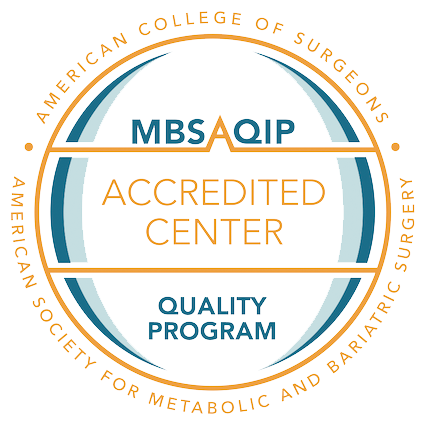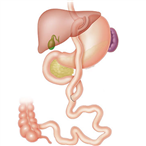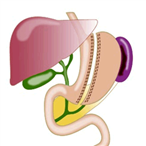Our Procedures
Roux-en-Y Divided Gastric Bypass (RYDGB)
Recognized as a very effective treatment of clinically severe obesity, this procedure combines a gastric restrictive operation with slow gastric emptying and reduced food absorption to provide lifelong help for clinically severe obesity.
Most RYDGB procedures can be performed laparoscopically or with minimally invasive surgery. Laparoscopic procedures produce smaller incisions, allow for a shorter hospital stay and provide a quicker recovery. This operation divides the stomach into a small and large portion.
When the small, functioning upper stomach pouch is full (after only a few bites), patients will feel full and satisfied. In this way, the intake of food is dramatically limited and appetite is reduced. The rerouting of the small intestine slows food passage and mildly reduces absorption.
The Roux-en-Y Divided Gastric Bypass currently is the second most common Bariatric Procedure in the United States due to the acceptable complication rate and long-term proven results in achieving weigh loss. This procedure carries a national mortality rate of less than ½ percent, an operative morbidity (complication) rate of five to ten percent and an effective reduction on average of 50 to 70 percent of excess weight. In most cases, this is enough weight loss to reduce the life threatening diseases which comes with co-morbid obesity conditions.
Most average patients will lose as much as 100 pounds of about two thirds of their excess weight in one year. Some will lose a little more, some a little less. Weight loss may continue slowly during the second year.
Learn more abot surgery options
Sleeve Gastrectomy or Laparoscopic Gastric Sleeve
The “Lap-Sleeve” is the newest weight loss operation. The first Lap-Sleeve was done in 2004. With this operation a portion of the stomach is removed. This operation is mostly restrictive without the use of a foreign body like with the lap band.
The pouch is larger than with either the band or the bypass.
The pouch is a long, narrow tube between the esophagogastric junction and the distal part of the stomach. Food passes through the long narrow tube very slowly maintaining hunger control for a long time.
So far, complication rates with Sleeve Gastrectomy have been very low. Weight loss results have been close to the same as with the bypass. Sleeve can be converted to bypass should that be necessary for more weight loss in the future.
Learn more about surgery options



